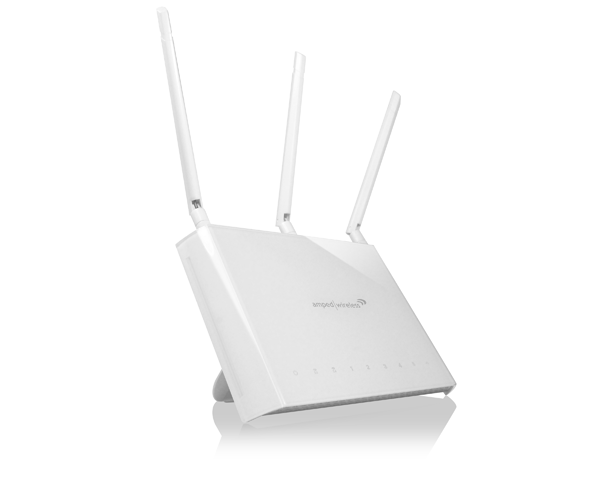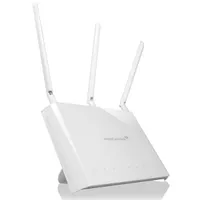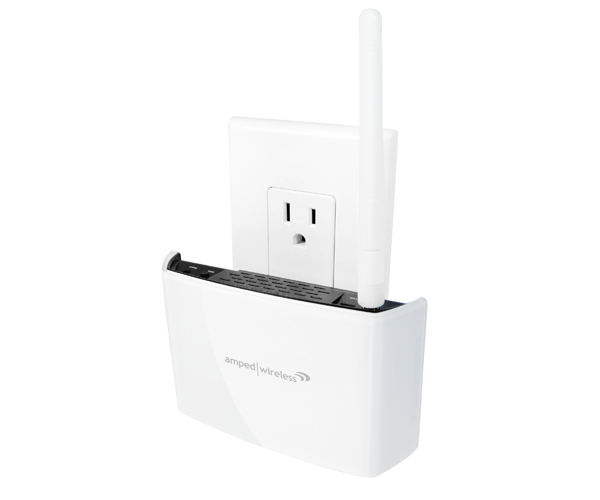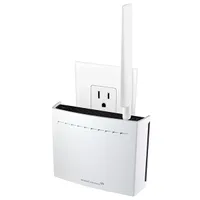Wireless Range Extender 101
Hardware
Range extenders commonly come in two form factors: devices designed to sit on a shelf or mount on a wall like a wireless access point or router, and those that mount directly on a power outlet. Both form factors offer some basic functionality that you can expect to find on any range extender. Antennas for the wireless network can be either internal or external, though external antennas can be expected to provide better signal. LED indicators are usually made available in order to be able to see the status of your network connectivity or provide other troubleshooting information.
Most range extenders designed to sit on a shelf offer connectivity for wired devices in the form of four or five gigabit Ethernet ports. Additionally, many of these devices provide a USB port to accommodate storage for file sharing or media server purposes, or even the option to share a USB printer on your network. Because of their size, these range extenders often provide increased performance over their outlet-mounted cousins through more robust processors or higher-powered amplifiers.
Outlet-mounted range extenders are often smaller in order to reduce weight and not place stress on the outlet. Because of size restrictions, these range extenders usually offer only one Ethernet port for wired devices and no USB port, and may not have the same performance capabilities as larger shelf-mounted units. What they give up in performance and capability they make up for in convenience. They're perfect for placing in a closet, hallway or behind furniture.
Get Tom's Hardware's best news and in-depth reviews, straight to your inbox.
-
James Mason I bought a media bridge for my bitcoin miners so I could put them in the kitchen where it's cooler and there is more free outlets and also it's on a different circuit than the rest of my apartment. Of course I only spent like $40 on it because bitcoin mining isn't super internet intensive. These extenders are more expensive than alot of routers though, so they don't exactly seem worth it.Reply -
wtfxxxgp I still see the relative value of the smaller, outlet-based units. These are useful because of one main issue: ease of use. The only real short-coming is that they require all parts of your house to be on the same circuit, which in some cases is not the case. I don't want a long story just to be able to get internet or network access to every room in my house - I want a simple solution that works and doesn't cost me an arm and a leg. My experience with a unit I bought has been amazing - I do not know why I kept forking out money on USB-based wi-fi dongles for my gaming PC in the past. It took me literally 2 minutes to connect my PC to my network in a "wired" fashion and my ping and stability since doing that has been outstanding. I highly recommend those units, especially if you have more than 1 PC that requires networking in your house, and you want to be able to go to any room with a wi-fi-reliant device and get a strong wi-fi signal. No hectic cables, no fuss, no insane costs and the best part is, if you move, they move.Reply -
LostAlone ReplyI still see the relative value of the smaller, outlet-based units. These are useful because of one main issue: ease of use. The only real short-coming is that they require all parts of your house to be on the same circuit, which in some cases is not the case. I don't want a long story just to be able to get internet or network access to every room in my house - I want a simple solution that works and doesn't cost me an arm and a leg. My experience with a unit I bought has been amazing - I do not know why I kept forking out money on USB-based wi-fi dongles for my gaming PC in the past. It took me literally 2 minutes to connect my PC to my network in a "wired" fashion and my ping and stability since doing that has been outstanding. I highly recommend those units, especially if you have more than 1 PC that requires networking in your house, and you want to be able to go to any room with a wi-fi-reliant device and get a strong wi-fi signal. No hectic cables, no fuss, no insane costs and the best part is, if you move, they move.
I absolutely agree with this. Powerline adapters are amazing things, a substantially better answer than wifi for a lot of typical stuff like media streaming and reasonably high-traffic internet use. They aren't without their problems (our ones needs the occasional reset) but they really are a better answer in so many homes where wifi is spotty. -
bliq ReplyI still see the relative value of the smaller, outlet-based units. These are useful because of one main issue: ease of use. The only real short-coming is that they require all parts of your house to be on the same circuit, which in some cases is not the case. I don't want a long story just to be able to get internet or network access to every room in my house - I want a simple solution that works and doesn't cost me an arm and a leg. My experience with a unit I bought has been amazing - I do not know why I kept forking out money on USB-based wi-fi dongles for my gaming PC in the past. It took me literally 2 minutes to connect my PC to my network in a "wired" fashion and my ping and stability since doing that has been outstanding. I highly recommend those units, especially if you have more than 1 PC that requires networking in your house, and you want to be able to go to any room with a wi-fi-reliant device and get a strong wi-fi signal. No hectic cables, no fuss, no insane costs and the best part is, if you move, they move.
I absolutely agree with this. Powerline adapters are amazing things, a substantially better answer than wifi for a lot of typical stuff like media streaming and reasonably high-traffic internet use. They aren't without their problems (our ones needs the occasional reset) but they really are a better answer in so many homes where wifi is spotty.
we actually use a PLN kit that has a 802.11N access point on the remote side built into the remote side plug. I think it cost $29. works perfectly (although our new router has such good range I don't actually think we need it anymore). -
Rookie_MIB I just picked up an Amped wireless range extender, and I have to admit, it's a pretty effective piece. I was having intermittent signals in the back of the facility (we use Square card readers with cellphones for CC transactions...) and the device would go offline since it was pretty far from the front router (about 200ft away).Reply
Put in one of the 'high power' extenders in (broadcasts at 600mw (!!!!) and actually placed it right beside the existing router, and have 70% signal strength all the way to the back now. Pretty darn impressive. -
melanfred I purchased a Netgear pair of Powerline + Access Point. This was a great solution. The Netgear boxes are small and unobtrusive, and I can get > 20 Mbps at the farthest reaches of my house. No problems with Roku, the signal is strong and consistent. Very little resetting needed,maybe once every 3 months, I reset the access point. The pair only cost $70, this was a much better solution than a WiFi extender. Just place the units about 40 feet apart, preferably on the same circuit. A light will change color to show you if you are connected at the highest speed.Reply -
Travis Hershberger Range extenders can be a good solution in a home where you only need a single one to get good coverage over the entire property. They absolutely kill performance when more than a single one is used, each extender is going to cut throughput by half. Add the fact of current WiFi standards all being half-duplex and you get abysmal performance real quick.Reply



